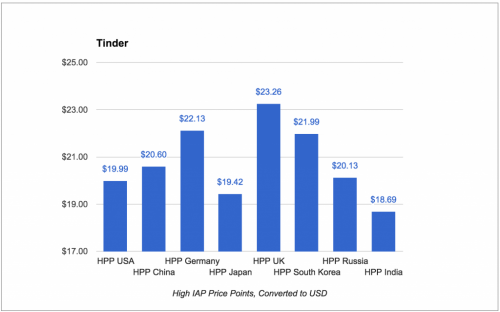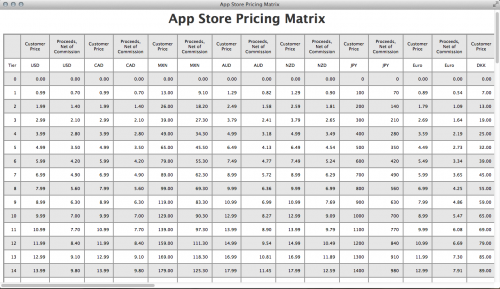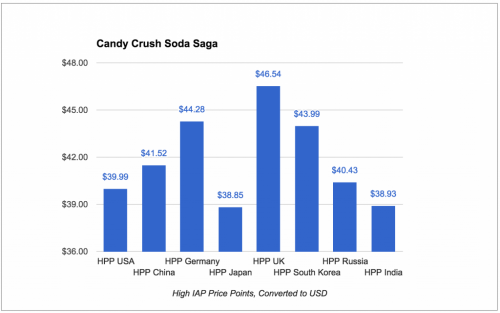Eric Seufert, vice president of acquisition and user engagement at Rovio, explained exactly how Apple creates prices in the App Store, and why this system needs to be improved.
The original version of the material can be found on Mobile Dev Memo, a website dedicated to the mobile industry, run by Eric Seferth himself, author of the book Freemium Economics.
In early July, Apple announced that it would change the system that dictates exactly how much developers can request for an IAP. As part of this system, the developer chooses the price segment to which the IAP will belong, and the specific purchase price is set by Apple itself, depending on the territory in which the application is distributed. This article discusses in detail the pricing system of the company; the figure below shows the previous model of the price matrix.
The previous model of Apple’s price matrix
The changes announced by Apple included various price adjustments that were designed to compensate for currency fluctuations (for example, an increase in the euro price tag was supposed to offset the depreciation of the European currency against the dollar).
In addition, the company has introduced two new minimum price tags for stores in India, Mexico, Russia, South Africa and Turkey (similar price tags previously appeared in the Chinese App Store). Prior to that, Apple last updated the price matrix in January to adjust prices in accordance with changes in EU taxation.
“Cheap” price tags allow developers to correlate IAP with the average GDP of the country and thus increase their attractiveness. But, although the standard prices are reduced, developers do not have the opportunity to optimize the cost of purchases depending on the country.
From Apple’s point of view, allowing developers to give residents of some countries preferential price terms compared to residents of other countries is a good idea. For example, for residents of India, IAPs are offered at a price that is 1/33 of the standard microtransaction in the US store, which reflects the difference in the GDP of the two countries. But such a strategy does not allow the developer to get a production surplus in each of the markets, which is one of the main advantages of dynamic IAP evaluation in the freemium model.
Apple changes the price tags manually and creates arbitrary intervals between them. The company applies an adjustment to the purchasing power of currencies – but with restrictions. This means that the absolute price of the IAP varies from currency to currency.
Using the example of Game of War, Candy Crush Soda Saga, Tinder and Skype, let’s look at how the absolute value of the most expensive purchase (HHP) in the App Store changes in dollars – in the USA, China, Germany, Japan, Great Britain, South Korea, Russia and India.
The conclusion from these diagrams is as follows: the developer cannot optimize the purchase price depending on geography. But the pricing strategy can be improved globally by optimizing the economy of the application for the target audience.
For example, why is the purchase price of  Tinder Plus $19.99
Tinder Plus $19.99 for the USA? Not because swipes [the ability to return the account you like, which is not available in the basic Tinder application, – approx. editors] are very expensive for the creators of the application. If the price tag became smaller, the conversion rate in lower-middle-income countries would increase. But at the same time, in countries where income is higher (including the United States), the consumer surplus would fall, which would eventually reduce the overall profit. That is, lowering the price for the application may be generally unprofitable, because users from the United States want to pay more for swipes. And the American market for the creators of Tinder is the target.
for the USA? Not because swipes [the ability to return the account you like, which is not available in the basic Tinder application, – approx. editors] are very expensive for the creators of the application. If the price tag became smaller, the conversion rate in lower-middle-income countries would increase. But at the same time, in countries where income is higher (including the United States), the consumer surplus would fall, which would eventually reduce the overall profit. That is, lowering the price for the application may be generally unprofitable, because users from the United States want to pay more for swipes. And the American market for the creators of Tinder is the target.
Thus, if the markets for different types of applications are not tied to the country’s GDP (for example, China, whose GDP is lower than in the United States, will become the largest mobile games market by 2016), then developers will have to think about choosing a price tag suitable for a particular country before the release of the application takes place. Price optimization based on the price sensitivity of American – or Western – users will not necessarily provide a high aggregate profit. Even on iOS.
A source: http://mobiledevmemo.com




